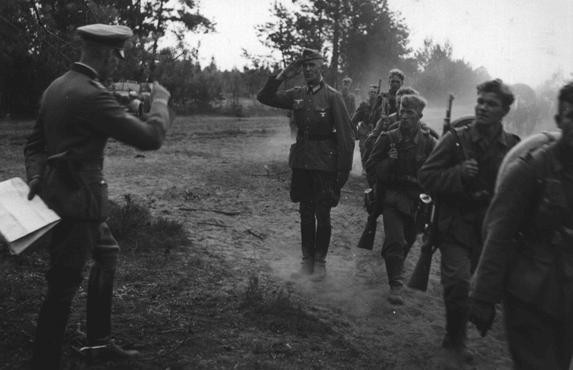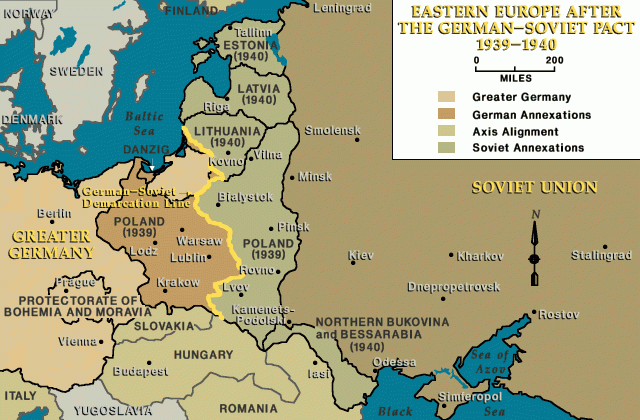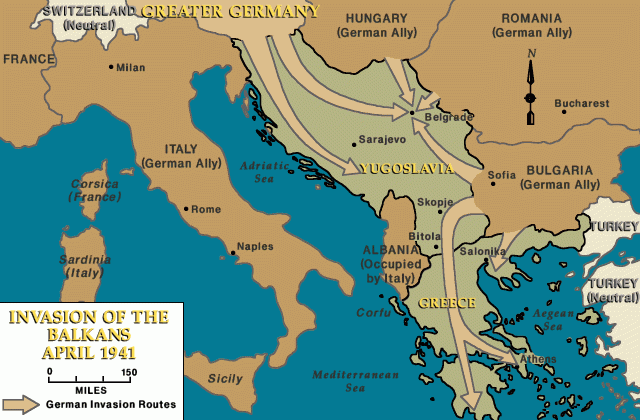
The Holocaust and World War II: Key Dates
The mass murder of Europe’s Jews took place in the context of World War II. As German troops invaded and occupied more and more territory in Europe, the Soviet Union, and North Africa, the regime’s racial and antisemitic policies became more radical, moving from persecution to genocide. Explore a timeline of key events during the Holocaust and World War II.
January 30, 1933
President Hindenburg appoints Adolf Hitler Chancellor of Germany.
March 20, 1933
SS opens the Dachau concentration camp outside of Munich.
April 1, 1933
Boycott of Jewish-owned shops and businesses in Germany.
April 7, 1933
Law for the Restoration of the Professional Civil Service.
July 14, 1933
Law for the Prevention of Offspring with Hereditary Diseases.
September 15, 1935
Nuremberg Race Laws.
March 16, 1935
Germany introduces military conscription.
March 7, 1936
German troops march unopposed into the Rhineland.
August 1, 1936
Summer Olympics begin in Berlin.
March 11-13, 1938
Germany incorporates Austria in the Anschluss (Union).
November 9/10, 1938
Kristallnacht (nationwide pogrom in Germany).
May 13, 1939
The St. Louis sails from Hamburg, Germany.
September 29, 1938
Munich Agreement. Germany, Italy, Great Britain, and France sign the Munich agreement, by which Czechoslovakia must surrender its border regions and defenses (the so-called Sudeten region) to Nazi Germany.
August 23, 1939
Nazi-Soviet Nonaggression Agreement.
September 1, 1939
Germany invades Poland, starting World War II in Europe.
September 17, 1939
The Soviet Union occupies Poland from the east.
October 8, 1939
German officials establish what is likely the first Nazi ghetto in Piotrków Trybunalski, Poland.
April 9, 1940
German forces invade Denmark and Norway.
May 10, 1940
Germany attacks western Europe (France and the Low Countries).
July 10, 1940
The Battle of Britain begins.
April 6, 1941
German forces invade Yugoslavia and Greece.
June 22, 1941
Germany invades the Soviet Union.
July 6, 1941
Einsatzgruppen (so-called mobile killing units) shoot nearly 3,000 Jews at the Seventh Fort (Fort VII), one of the 19th-century fortifications surrounding Kovno.
August 3, 1941
Bishop Clemens August Graf von Galen of Muenster denounces the “euthanasia” killing program in a public sermon.
September 29-30, 1941
Einsatzgruppen shoot about 34,000 Jews at Babyn Yar, outside Kyiv (Kiev).

November 7, 1941
Einsatzgruppen round up 13,000 Jews from the Minsk ghetto and kill them in nearby Tuchinki (Tuchinka).
November 30, 1941
Einsatzgruppen shoot at least 11,000 Jews from the Riga ghetto in the Rumbula Forest. The massacre continues on December 8-9. In total, at least 25,000 Jews are killed.
December 6, 1941
Soviet winter counteroffensive.
December 7, 1941
Japan bombs Pearl Harbor and the United States declares war on Japan the next day.
December 8, 1941
The first killing operations begin at Chelmno in occupied Poland.
December 11, 1941
Nazi Germany declares war on the United States.
January 16, 1942
Germans begin the mass deportation of Jews from Lodz to the Chelmno killing center.
January 20, 1942
The Wannsee Conference is held near Berlin, Germany.
March 27, 1942
German officials begin the deportation of more than 65,000 Jews from Drancy, outside Paris, to the east (primarily to Auschwitz).
June 28, 1942
Germany launches a new offensive towards the city of Stalingrad.
July 15, 1942
Germans begin mass deportations of nearly 100,000 Jews from the occupied Netherlands to the east (primarily to Auschwitz).
July 22, 1942
Germans begin the mass deportation of over 300,000 Jews from the Warsaw ghetto to the Treblinka killing center.
September 12, 1942
Germans complete the mass deportation of about 265,000 Jews from Warsaw to Treblinka.
November 23, 1942
Soviet troops counterattack at Stalingrad, trapping the German Sixth Army in the city.
April 19, 1943
The Jews of the Warsaw ghetto initiate their final act of armed resistance against the Germans. The Warsaw ghetto uprising begins.

July 5, 1943
Battle of Kursk.
October 1, 1943
Danish citizens initiate the mass rescue of Denmark's Jews.
November 6, 1943
Soviet troops liberate Kyiv.
March 19, 1944
German forces occupy Hungary.
May 15, 1944
Germans begin the mass deportation of about 440,000 Jews from Hungary.
June 6, 1944
D-Day: Allied forces invade Normandy, France.
June 22, 1944
The Soviets launch an offensive in eastern Belorussia (Belarus).
July 25, 1944
Anglo-American forces break out of Normandy.
August 1, 1944
The Polish Home Army initiates the Warsaw uprising.
August 15, 1944
Allied forces land in southern France.
August 25, 1944
Liberation of Paris.
December 16, 1944
Battle of the Bulge.
January 12, 1945
Soviet winter offensive is launched.
January 18, 1945
Death march of nearly 60,000 prisoners begins from the Auschwitz camp system in the southern part of German-annexed Poland.
January 25, 1945
Death march of nearly 50,000 prisoners begins from the Stutthof camp system in the northern part of German-annexed Poland.
January 27, 1945
Soviet troops liberate the Auschwitz camp complex.
March 7, 1945
US troops cross the Rhine River at Remagen.
April 16, 1945
The Soviets launch their final offensive, encircling Berlin.
April 29, 1945
American forces liberate the Dachau concentration camp.
April 30, 1945
Adolf Hitler commits suicide.
May 7-8, 1945
Germany signs an unconditional surrender at the headquarters of US General Dwight D. Eisenhower, Commander of Allied forces in northwest Europe, at Reims on May 7. The surrender takes effect on May 8 at 11:01 PM Central European time (CET).
May 8, 1945
Germany signs a second, very similar, document of surrender in Berlin. It also comes into effect on May 8 at 11:01 PM CET. In Moscow, this was already after midnight on May 9.
Critical Thinking Questions
- How can knowledge of the events in Germany and Europe before the Nazis came to power help citizens today respond to threats of genocide and mass atrocity in the world?
- While fighting against the Allied armies, how was the German army involved in the murder of the European Jews at the same time?
- What was the relationship between the progress of the war and the mass murder of Europe’s Jews?












